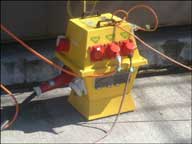12. Transformers
Transformers are simple electrical devices that have
- two separate coils of wire (electrical paths)
- an iron core (magnetic path)
- no moving parts.
How transformers work
Transformers have two electrical paths connected by a magnetic path.
They work in the following way:
- The Alternating Current in the first coil produces a changing magnetic field
- This changing magnetic field produces Alternating Current in the second coil.
- The iron core concentrates the magnetic field and makes the transformer more efficient.
- Altering the number of turns of wire in the coils alters the voltage produced.
Transformers do not work with Direct Current if the magnetic field is constant. This is because the magnetic field must be changing if electricity is to be generated in the second coil. (Faraday's Law)
Losses from Transformers
Because there are losses (usually heat) in both the electrical and magnetic paths, large transformers require a cooling system.
Iron losses are the losses in the magnetic circuit and are constant (not load dependent). They are basically the excitation losses, the effort needed to drive the flux.
Copper losses are the load losses due to resistance of the transformer windings (I2R losses) and obviously vary with the load.
The transformer's most efficient operating point is when the iron and copper losses are equal, but virtually no transformer operates at this point, because the transformer would have to be much bigger (more copper) and would be too expensive.



